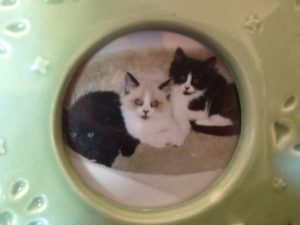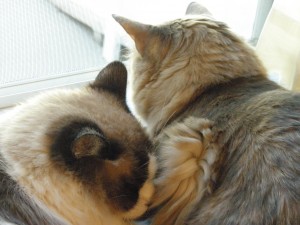 It was May. I stepped out into my garden just in time to see the shy black cat I’d seen many times before dash over the gate into our woodshed. I enjoyed having this young cat join me in the yard, although she always stayed her distance. I’d never touched her fur or heard her purr.
It was May. I stepped out into my garden just in time to see the shy black cat I’d seen many times before dash over the gate into our woodshed. I enjoyed having this young cat join me in the yard, although she always stayed her distance. I’d never touched her fur or heard her purr.
This day would be no different except that today, the shy black cat was not alone. Three perfect kittens followed her along the top ledge of the woodshed fence. When they saw me, the whole family lunged for cover into the crevices of the woodpile where unbeknownst to me, they planned to set up housekeeping. I’d been chosen custodian for the newest generation of neighborhood feral kitties. Now what?
I would tame them, that’s what! The kittens appeared to be about four-weeks old. If I  spent a lot of time nearby talking to them, they would surely get accustomed to my voice and my presence and soon come around. A couple of times a day for nearly a week, I perched myself on a bench outside the woodshed gate and watched the kittens play chase and hide-and-seek games through the woodpile. But when I spoke, moved or came too close, they’d disappear into the dank darkness under the scattered logs.
spent a lot of time nearby talking to them, they would surely get accustomed to my voice and my presence and soon come around. A couple of times a day for nearly a week, I perched myself on a bench outside the woodshed gate and watched the kittens play chase and hide-and-seek games through the woodpile. But when I spoke, moved or came too close, they’d disappear into the dank darkness under the scattered logs.
Braveheart, the smallest and most timid, was the image of her mother with sleek, black fur. Bella, the most curious wore a long black-and-white coat. Max was adorably stocky with lovely soft brown and white fur.
Ten days later, I realized that my loving overtures were not changing the kitten’s feral ways. In order to save them, we had to capture them.
We borrowed a large cage, donned leather gloves and moved the wood piece-by-piece by piece until we uncovered the three kittens huddled under a pallet. One by one, we placed the three frightened kittens into the cage and took them inside the house.
After leaving them alone for a couple of hours, I began to make regular visits. I spoke softly to them and touched their fur through the wire cage. They were terrified, but not aggressive. They were interested in their food and water, but didn’t seem to understand the reason for the sandbox.

Max and Lily Sharing Space
The next morning, I picked up each kitten and moved them to a bathroom where they had more room. The kittens didn’t bite, scratch, or even hiss, but it was clear that they were very frightened and that they did not enjoy my touch.
The kittens now had access to a carpeted cat tree with a circular bed on top, two sandboxes, kitten toys, kitten kibbles, and fresh water. I closed the toilet lid, removed all toxic cleaners and tied the mini blind cord safely out of reach. My plan was to visit the kittens often throughout the day every day until they were comfortable with the human touch. Then I would find them good homes.
The first time I went into the bathroom to spend time with the kittens, I couldn’t find them. I feared the worst—that they’d torn through the window screen and escaped. But I finally found them huddled deep inside an overturned wastebasket. This was to be their secure haven for the next seven days.
Since I work at home, I was able to keep a close vigil over the kittens. I visited them often—partly out of obligation to them and partly because I couldn’t stay away. I loved spending time with them and did so many times every day.
 After about a week, when I’d go into the bathroom, I’d find them sleeping, not deep inside in the plastic wastebasket, but in the little bed on top of the cat tree. Yet, while the kittens had calmed down, they were still not returning our affection. They allowed us to touch and hold them, but they didn’t respond until one Friday afternoon.
After about a week, when I’d go into the bathroom, I’d find them sleeping, not deep inside in the plastic wastebasket, but in the little bed on top of the cat tree. Yet, while the kittens had calmed down, they were still not returning our affection. They allowed us to touch and hold them, but they didn’t respond until one Friday afternoon.
During a routine visit to the bathroom/turned kitten room, I found the three kittens curled up together in their bed. I began petting them when all of a sudden, Max rolled over onto his back, looked up at me and started to purr. I was so touched that I began to cry. This was the first time any of the kittens had responded to my touch.
To give the kittens more space and more opportunities for socialization, we’d bring them into the living room at night. I’d also bring out things that were familiar to them like their cat tree, their food and water and, of course, their sandbox.
The kittens had a grand time playing in the larger area and we loved watching them. This also gave the resident cats (Katy, Dinah, and Winfield) the opportunity to become acquainted with the kittens under our supervision. The kittens kept a wary eye on us, though and were quick to dart for cover, should we move toward them. This made it difficult to recapture them and return them to their safe haven. Our goal was to make their life as trauma-free as possible, but we weren’t always successful.
When the kittens were about 7-weeks old, I took them to see the veterinarian. He was

Max
surprised at how healthy they were, given their precarious beginnings. They got their first shots and a clean bill of health.
About the same time, I spoke with animal behaviorist, Anders Hallgren. I told him that, although I’d been working with the kittens for three weeks and that they were more gentle, they were still not really responding to us. He said, “You’ve got to separate the kittens. They’re bonding with each other and as long as they have each other, they may not bond with you.”
Now that made sense. I tried to figure out a way to separate the kittens and work with them myself. My first step was to bring Max out and let him have the run of the house. On that eventful day, I held Max for a while—he was beginning to enjoy petting now. I fed him a couple of small pieces of chicken by hand and then, when he wanted down, I let him go.
He played, explored, peed in a basket of firewood, and tried to get to know the resident cats. After thirty minutes or so, Max looked around the room, spotted me and came trotting over to where I was sitting. I reached down, lifted him onto my lap where he lay contentedly for a while before rushing off to pursue more adventure. By then, I knew that I could not give up on Max. Whether he was bonding with me or not, I had certainly bonded with him. That night he slept next to me on my bed and did every night after that for nearly eighteen years.
In the meantime, my veterinarian had told me about a couple of people who were looking for kittens and had homes that he felt were suited to these special needs kittens. Within a day and a half, both kittens had just the sort of homes I’d imagined for them.
Max became a lovely pet and a totally indoor cat. He was sweet, affectionate, funny, eager to please and clever. He responds when he heard his name almost every time. Except for his ability to dive for cover at top speed when hearing thunder, the garbage truck, the vacuum cleaner, or a sneeze, and the joy he derived from the blanket tents and box caves we build for him to play in, one would never guess that he had such humble beginnings.
I ask myself if I’d go to the trouble again to rescue feral kittens. My answer came easy when I’d look down at Max resting contentedly, relaxed and trusting in my lap. Yes! I’d do it again in a heartbeat.






What a gorgeous kitty! Who said you can’t find a Snowshoe mix as a rescued feral? I wish more people would do the same when they find a litter of kittens. What happened with the mom?